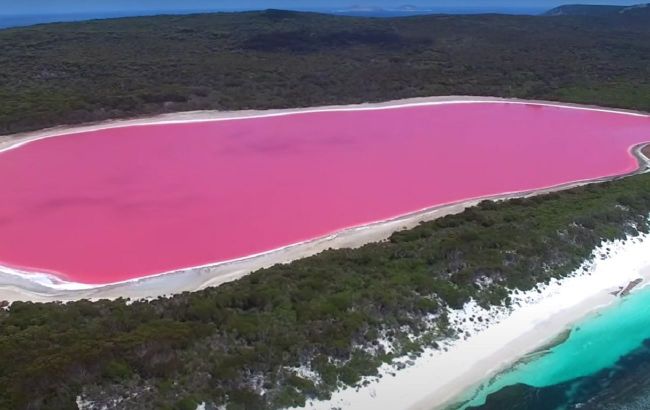World's most beautiful pink lake: Why there are no tourists
 Hillier is a unique pink lake (photo: screenshot from youtube.com/@jaimen)
Hillier is a unique pink lake (photo: screenshot from youtube.com/@jaimen)
Our planet is full of amazing natural phenomena, and Lake Hillier in Australia is a striking example. Among the millions of bodies of water on Earth, this one stands out for its bright pink color that looks almost unreal, even in photographs. Here’s what makes Lake Hillier so special, why it's so vividly colored, and why not every tourist can see this beauty in person.
Unique beauty of pink lake
Lake Hillier is located on Middle Island, part of the Recherche Archipelago off the coast of Australia. It was discovered by British navigator Matthew Flinders in 1802 when he climbed the island’s highest point. Upon seeing the bright pink lake, he was so impressed that he mentioned it in his journal.
The lake is surrounded by dense eucalyptus trees, which sharply contrast with the vivid pink water. The color is best seen from the air, which is why aerial photos of Hillier have become so popular. Unlike other colored lakes around the world, Hillier maintains a consistently bright pink hue all year round.

Properties of water and its salinity
The lake is not very large—about 600 meters long and 250 meters wide. It’s relatively shallow, but the salt concentration is much higher than in ocean water. Because of this, a person can easily float on the surface without any effort.
In the first half of the 20th century, attempts were made to extract salt from the lake, but these quickly stopped due to how difficult the location was to access. The water’s color can vary slightly, from bright pink to deep mauve, depending on the weather. Despite the bright color, the water is safe for swimming and contains no toxic substances.
 You can see how much salt there is at the edge of the water (photo: Wikipedia)
You can see how much salt there is at the edge of the water (photo: Wikipedia)
Real reason of pink color
Many lakes around the world change color due to algae or minerals that enter the water. For example, India’s Lonar Lake changes color due to the activity of red algae in hot seasons.
As for Hillier, for a long time, it was believed that the pink color came from certain algae, but early research did not confirm this. Only in 2016, through the Extreme Microbiome Project, were the algae Dunaliella salina identified.
These algae produce carotenoids—pigments that give the water its pink hue. These same compounds are used in dietary supplements as a source of vitamin A.
 The lake is located in a difficult-to-reach place (photo: Wikipedia)
The lake is located in a difficult-to-reach place (photo: Wikipedia)
Why there are almost no tourists there
Despite its incredible beauty, Lake Hillier remains almost completely inaccessible to most tourists. It is located in a difficult-to-reach area, and the dense forests around it have no established trails. The only way to reach the lake is by helicopter or a special sightseeing plane.
Because of this, visiting the lake is an expensive experience, available to only a few. That’s why there are very few traveler photos of this place on social media, even though it attracts a lot of interest. Lake Hillier remains one of Australia’s most mysterious and little-known natural landmarks.
Earlier, we wrote about 9 travel myths almost everyone believes—and pays dearly for.
Sources: Rarest.org, Solo Travelling, Wikipedia

